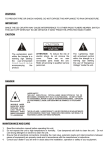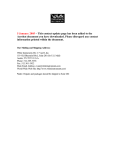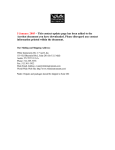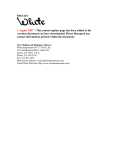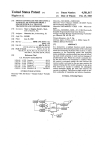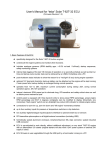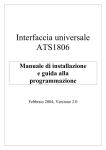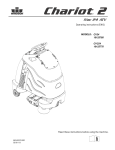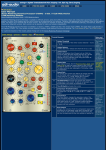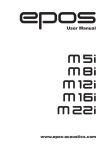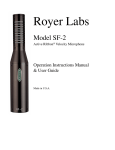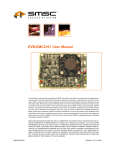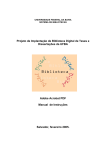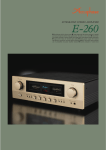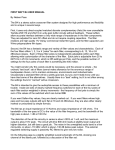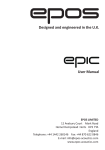Download Specifications: Models 4100, 41OORM
Transcript
5 January 2005 – This contact update page has been added to the Acrobat document you have downloaded. Please disregard any contact information printed within the document. Our Mailing and Shipping Address: White Instruments Div. C Van R, Inc. 1514 Ed Bluestein Blvd., Suite 201 (for U.S. Mail) Austin, TX 78721 U.S.A. Phone: 512-389-5358 Fax: 512-301-3932 Main Email Address: [email protected] World Wide Web Site: http://www.whiteinstruments.com/ Note: Repairs and packages should be shipped to Suite 202 Model 4100 Two Channel Active LC Octave Band Equalizer NOTE: This document was reconstructed from the original printed Users' Manual. Specifications: Models 4100, 41OORM ............................................................................. 2 ELECTRICAL ................................................................................................................ 2 MECHANICAL .............................................................................................................. 3 OPTIONS ........................................................................................................................ 3 MODEL 4100 STEREO EQUALIZER USER'S MANUAL ............................................. 4 INTRODUCTION........................................................................................................... 4 UNPACKING ................................................................................................................. 4 CONNECTION TO THE SYSTEM ................................................................................... 4 CONTROLS.................................................................................................................... 8 POWER ON-OFF: ...................................................................................................... 8 EQ IN-OUT:................................................................................................................ 8 LEVEL: ....................................................................................................................... 8 OVERLOAD:.............................................................................................................. 8 ACCESSORY SOCKET:............................................................................................ 9 ADJUSTMENT AND EQUALIZATION ...................................................................... 9 BI-AMPLIFICATION .................................................................................................. 11 OTHER APPLICATIONS ............................................................................................ 12 CIRCUIT DESCRIPTION............................................................................................ 13 WARRANTY:............................................................................................................... 18 Damage in Shipment: .................................................................................................... 18 Return Shipment: .......................................................................................................... 18 Schematic Diagram: .......................................................................................................... 19 1 Specifications: Models 4100, 41OORM ELECTRICAL CIRUITRY: 2 IC quad amplifiers, 2 IC regulators, 2 transistors, 2 zener diodes, 6 diodes, and 3 LED's. Precision-tuned inductors in all negative feedback circuit, magnetically shielded for low hum pickup. OPERATING RANGE (FREQUENCY): 20 Hz (-3 dB) to 20 kHz (-1 dB). CONTROL AANGE(FREGUENCY): Ten bands (each channel) on one octave I.S.O. centers from 31.5 Hz to 16 kHz. CONTROL RANGE (AMPLITUDE): -10 dB to +10 dB, continuously variable. LOW-CUT CONTROL: 12 dB/octave active high-pass filter, continuously variable from 20 Hz to 160 Hz. GAIN: Unity gain with all controls in flat position. Calibrated attenuator at input of each channel for level setting. OPERATING LEVEL (INPUT): 0 dBm (approximately 0.8 Vrms) recommended. MAXIMUM OUTPUT: +18 dBm with all controls in flat position. OVERLOAD DETECTOR: Peak level detector set approximately 2 dB below maximum peak output. LED indicators. DISTORTION (THD): Less than .08% at 0 dBm, worst case control settings; less than 0.1% at +18 d Bm. (IM): Less than .004% (SMPTE). NOISE: Better than -92 dBm (19 microvolts) over 20 kHz bandwidth. DYNAMIC RANGE: 110 dB. INPUT IMPEDANCE: Greater than 40 kilohms, single ended, AC coupied. OUTPUT IMPEDANCE: Approximately 100 ohms. OUTPUT LOAD: 600 ohms or greater. FREGUENCY TOLERANCE: ±6% of center frequency. 2 115/230 Vac nominal, 50-60 Hz. Fused for 1/2 am . Front anel ilot li ht. POWER: MECHANICAL CONTROLS: Rotary potentiometers, sealed MIL-SPEC type. EQ IN-OUT switch, power switch. CONNECTIONS: Standard phono type plus chassis ground terminal. DIMENSIONS: 18-1/2 inches by 6-3/4 inches by 3-1/2 inches (47 cm x 17.2 cm x 8.9 cm). WEIGHT: 7-1/2 pounds (3.4 kg). FINISH: Black anodized aluminum with solid walnut trim. SEGURITY COVER: Furnished with either standard table model or with rack mount option. OPTIONS BI-AMP NETWORKS: Plug-in networks provide crossover separation for bi-amp systems. Order 4101-frequency for 12 dB/octave or 4102-frequency for 18 d8/octave. Specify Model 4100 RM. RACK MOUNTING: !WARNING! TO PREVENT FIRE OR SHOCK HAZARD DO NOT EXPOSE THIS APPLIANCE TO RAIN OR MOISTURE. 3 MODEL 4100 STEREO EQUALIZER USER'S MANUAL INTRODUCTION Congratulations'. You have purchased the finest one octave stereo equalizer that money can buy. White Instruments stands behind this product, as we do all products we manufacture, in guaranteeing that the highest standards of quality and craftsmanship have gone into the construction of your Model 4100 Stereo Equalizer. Properly installed, this unit will provide you with years of trouble-free operation. Please read the instructions carefully – by following them you will realize a standard in music reproduction that previously could only be hoped for. UNPACKING Your Model 4100 Stereo Equalizer has been carefully packaged to minimize the possibility of damage during shipment. When you receive your unit, unpack and carefully inspect it. If there is any obvious damage, report it immediately to the dealer from whom you purchased it or to the carrier who delivered it. Save all packing materials for inspection by the dealer or carrier. As all products from White Instruments are shipped F.O.B. Factory, we are not responsible for damage incurred during shipment; however, we will assist you in obtaining rapid repairs or replacements. Inside the plastic foam shipper you will find the following: l. One Model 4100 Stereo Equalizer 2. One Security Cover 3. Two hi-fi stereo patch cables 4. One 3-wire line cord adaptor 5. One User's Manual 6. One set of hardware (if you ordered the 4100RM (rack mounting) unit) We recommend you retain all packing materials in case the unit must be returned to your local service center or the factory for repair. CONNECTION TO THE SYSTEM NOTE: Even if you do not like to read instructions, please read the section, CONNECTION TO THE SYSTEM, to protect your investment in your music system. It is possible to damage some high frequency loudspeakers or tweeters by excessively boosting the upper portions of the spectrum. The Model 4100 Stereo Equalizer is designed to be connected between your preamplifier and your power amplifier. The instructions for doing this follow. The input impedance of the Model 4100 is high – greater than 40,000 ohms. This means that it will not appreciably "load" the output. circuit of modern high fidelity preamplifiers and may be connected without consideration of impedance matching methods. The output 4 impedance of the Model 4100 is very low – less than 100 ohms. The output stages are capable of driving following circuit impedances as low as 600 ohms without exhibiting any loading effects. Most high fidelity power amplifiers have input impedances of 50,000 ohms or greater and loading of the Model 4100's output circuit will not have to be considered. The average signal level between the preamplifier and the power amplifier at the loudest volume setting you intend to use should be considered. The Model 4100 is capable of putting out levels as high as +18 dBm (about 6.0 volts). If it happens that you have used one of the cut/boost controls to boost a particular band by +10 dB, then the input signal must not exceed +8 dBm or it is possible to overdrive the output circuit. To allow head room for average program material, you do not want the average input level to exceed 0 dBm. However, there are these considerations: First, the average modern high fidelity power amplifier is generally driven to full output by signals on the order of +8 dBm (2 volts) or less. Second, in the following explanations on equalization you will see that most of your adjustment is done in the cut mode. We recommend that the average signal level of the circuit into which the Model 4100 is inserted by between -20 dBm (.078 volts) and 0 dBm (0.78 volts) for the best head room and signal-to-noise considerations. This will be easily achieved with practically all receivers or component systems. In the event the maximum output level of the Model 4100 is approached, the OVERLOAD lamp on the front panel will begin flashing at an output level of approximately +16 dBm. Insertion of the Model 4100 into your system is simple. In a RECEIVER or INTEGRATED AMPLIFIER type system it is only necessary to remove the jumper cables or plugs between the PREAMP OUT and the POMER AMP IN jacks on the rear of the chassis (see Figure 1). The PREAMP OUT is connected via the supplied hi-fi patch cable to the INPUT jacks on the rear of the Model 4100. Be sure to observe the order of the left and right channel connections. OUT 1 (NORM) of the Model 4100 is then patched back into the POWER AMP IN of the receiver, again observing the order of the left and right channels. A chassis grounding terminal is provided on the rear of the Model 4100. In some instances it may be necessary to connect a wire from this terminal to a similar terminal on your preamplifier or receiver. The internal circuit ground is not connected to the chassis at any point. To insert your Model 4100 into a component system, the same procedure is followed: Connect the OUTPUT of the preamplifier to the INPUT of the Model 4100. The OUT 1 (NORM) of the Model 4100 then goes to the power amplifier INPUT (see Figure 2). If you have purchased an optional BI-AMP CROSSOVER NETWORK (Type 4101-f or 4102-f ) with your Model 4100, you will use the following procedure: Connect the INPUT to the Model 4100 as previously described. The OUT 1 (NORM) will be connected to the pair of amplifiers associated with the LOW frequency speakers or woofers. OUT 2 will be connected to the amplifiers associated with the HIGH frequency speakers or horns (see Figure 3). CAUTION: Do NOT reverse OUT 1 and OUT 2 as this will cause the LOW frequency signal to be fed into the HIGH frequency speakers or horns and may damage or destroy them! 5 6 7 NOTE: The EQ IN-OUT switch on the front panel does NOT switch the BI-AMP crossover networks out of the circuit when in the OUT position; only the equalizing portion of the Model 4100 is switched out, thus still enabling you to utilize the electronic crossover portion of the system even though all of the equalization has been removed. This allows you to "A-B" your bi-amped system without fear of putting low frequency signals into delicate horns or tweeters. CONTROLS POWER ON-OFF: This switch controls the power to the unit. The Model 4100 may be connected to the switched power plugs provided on the rear of most receivers and preamplifiers. In this manner, the POWER switch of the Model 4100 may be left in the ON position and the unit controlled from the main switch of the system. A pilot lamp in the center of the front panel indicates whether or not the unit is on. EQ IN-OUT: This switch inserts or removes the frequency shaping controls of the Model 4100 from the system. This allows you to go from your "raw" or unequalized system to the equalized system for comparison. This switch will not affect the bi-amp crossover network if inserted in the rear accessory socket. LEVEL: The level controls are used when excessive signal levels are encountered which may overdrive the Model 4100 or the following components in the system. By using these calibrated attenuators which are at the input to the Model 4100, incoming signals may be attenuated to a suitable level. These controls may also be used for balancing the system after equalization to assure the system volume is the same in both the left and right channels. OVERLOAD: These panel lamps indicate if the Model 4100 is driven by signals exceeding +16 dBm (5 volts). While the full output of the Model 4100 is +18 dBm, the indicating point of the overload circuit is set about 2 dB below this level to warn the user he is approaching overload conditions. LOW CUT: The LOW CUT controls are very important to the proper operation of your music reproduction system. These controls vary the cutoff point of a 12 dB/octave high-pass filter from 20 Hz to 160 Hz. By proper adjustment unwanted and distortion-causing low frequency transients are kept from the power amplifier and speakers. (See curves in CIRCUIT DESCRIPTION section.) 8 OCTAVE BOOST/CUT: These controls are the heart of your Model 4100 Stereo Equalizer. It is with these controls that the electrical response of your system is adjusted to complement the acoustics of the listening environment. Each of these controls is centered on an International Standards Organization (I.S.O.) octave center from 31.5 Hz to 16 kHz. Each control allows you to cut the signal level within its band by as much as 10 dB or to boost it as much as 10 dB. With the control center at the 0 dB position the response in that band is not affected. Most importantly, adjacent octaves are buffered from one another electronically to minimize reactive tuning effects between channels. In addition, White Instruments' unique all negative feedback circuitry gives mirror image response in both the boost and cut modes for the utmost in control. ACCESSORY SOCKET: This socket on the rear of the Model 4100 chassis allows insertion of special bi-amp crossover networks for sophisticated four-amplifier bi-amplified stereo systems. These networks are available in either 12 dB/octave or 18 dB/octave slopes to match the response of the system loudspeakers. Please note that for operation without a crossover network inserted, jumpers must be inserted between pins 4 and 8, and pins 2 and 9. The units are shipped from the factory with these jumpers installed. ADJUSTMENT AND EQUALIZATION Before beginning the adjustment of your Model 4100 Stereo Equalizer, the rest of your music reproduction system must be in good order. Speaker placement is most important. While there are no firm rules to follow in this regard, it will at least be assumed that the speakers are located to give adequate coverage to the listening area. To begin the equalization process, set the OCTAVE BOOST/CUT controls of the Model 4100 to the FLAT or 0 dB position. The LOW CUT control should be set to the lowest frequency (extreme counterclockwise) position. The EQ IN-OUT switch should be in the IN position. LEVEL controls should be set at their 0 dB positions unless attenuation is necessary to prevent overloading. To properly adjust the Model 4100, equipment capable of making acoustic measurements is necessary. The preferred method utilizes a REAL TINE ANALYZER. To carry out the following procedure utilizing a real time analyzer, we suggest you consult with your equipment dealer or high fidelity consultant for either rental of the necessary equipment or the hiring of his services in assisting you in installing your equalizer. Since all high quality components of a sound reproduction system will faithfully reproduce the program material fed through them, it follows that equalization is principally for the part of the system that is not under full control -- the room in which you will listen. In equalization procedures it has been found sufficient to measure and then control the "average" response of a room over a specific interval. In professional systems for large rooms the one-third octave (i.e., about the space covered by four consecutive notes in the scale) is the amount of frequency interval that each adjustment will control. In a personal 9 music system in a normal room, adjustment over full octave intervals is satisfactory. Ways to measure and adjust the average response for each octave interval follow. The most commonly used procedure of measurement and adjustment is to connect a pink noise generator to an appropriate input into the preamplifier. The system then generates acoustic noise in the room that excites all octaves with equal power. Analysis of the room sound is then made with a standard microphone and a real time analyzer. To carry this out, first connect the pink noise generator to one channel only of the stereo system. Make certain that your preamplifier's or receiver's tone controls and loudness control are in the FLAT position. START OUT AT A VERY LOW LEVEL AND ADJUST THE GAIN CONTROLS CAREFULLY TO A CONVENIENT MEASURING LEVEL. MAKE CERTAIN THAT ALL HIGH FREQUENCY BOOST CONTROLS IN THE MODEL 4100 ARE IN THE FLAT POSITION. HIGH FREQUENCY DRIVERS CAN BE BURNED OUT BY ENERGY THAT THE EAR DOES NOT HEAR. Next, a standard microphone compatible with the analyzer is placed in the center of the listening area. With this pickup feeding the real time analyzer you are ready to begin some adjustment of the individual controls. First, you must consider what type of house curve (i.e., the room response) you prefer. Under some circumstances you might want all octaves to have equal response, or a flat house curve. This is not necessarily the best choice. Since high frequency sound is absorbed preferentially in most rooms, the natural condition to which we are accustomed is a gradual roll-off above 2 kHz. If the sound system is forced to make the room response appear flat, you will probably not be satisfied with the excess high frequency acoustic level that results. The response curve to which you try to make the system conform will probably fall off at a rate of about 3 dB in each octave above 2 kHz (see Figure 4). In the end, listening will determine the choice. The owner must satisfy his own ear in making the choice of what to do with the high frequency end of the spectrum. He should not hesitate to make the measurements drop off smoothly above 2 kHz at whatever rate he finds pleasing. Figure 4 When the real time analyzer has indications in one-third octave intervals, some averaging of the three readings that make up an octave must be made. It will probably be acceptable to average the readings in dB's since all three should be nearly the same. If there are large variations from one channel to the next in the one-third octave analysis, there evidently are some room resonances that will cause trouble later on and, if possible, some experiments in speaker placement should be made. After taking an average reading for 10 each one octave interval, adjust the equalizer controls carefully. No large boost setting should be used. Generally speaking, there should be at least as many cut settings as there are boost settings. Working through the spectrum, each channel requiring it is adjusted keeping in mind the comments above on rolling off the high frequency. As the adjustment process nears completion, try moving the microphone around in the listening area. Response dips may be discovered necessitating compromises on the best setting. Keep in mind that perfect flatness is approximated only in the most specialized rooms designed for monitor purposes, and small deviations will not be discoverable in later listening tests. After one channel has been equalized, the process is repeated for the other side. Another common test method uses recorded noise on a standard record. The noise record is played through the system and a sound level meter is used in the listening area to measure the acoustic level. Usually, the C-Scale setting on the meter is used unless it is a flat standard sound level meter. Again using only one channel at a time, the recorded noise is followed through its program, and readings are noted as a preliminary to adjustments. It may be that the only recordings available are in standard one-third octave bands. Again an averaging of readings must be made. A first set of approximate adjustment of the one octave controls is made and followed by another run to compute smaller corrections to arrive at a desired house curve. It is possible that a trained ear can attain some improvement by listening and adjusting. A noise recording should at least be available to provide uniformity of signal level. Adjustment while program material is being played will probably not lead to a satisfactory result. As a final adjustment ve should consider the low-cut controls. It is important that energy at very low frequency should not enter the bass speakers to cause bottoming of cones through unwanted excursions. The ear does not profit as much as might be imagined from an attempt to reproduce the lowest frequencies. Above all, the octave controls should not be used to boost a deficient bass capability more than a few dB. In the end, if the ear is best pleased by setting the low-cut controls at a higher frequency than 20 Hz, then you should not hesitate to do so. After a satisfactory set of adjustments has been arrived at, all settings should be logged for future reference on the label provided in the security cover. In this manner, later experimental adjustments may be made but the original settings can then be recovered. The security cover should be dropped into place when the work is finished. An equalizer is a superlative challenge to the knob twiddler that lurks in all of us. BI-AMPLIFICATION Many of today's music reproduction systems utilize a technique called "bi-amping". This is a means by which the high frequency and low frequency speakers are driven by separate amplifiers. In a stereo system this means that there will be four amplifiers, two for each channel. There are several aspects of bi-amped systems but this manual will not discuss them with the exception of one: the crossover network. 11 All sound systems usi.'ng separate high frequency and low frequency speakers must have a crossover netvork. The crossover network divides the audio spectrum into two parts, a low frequency part and a high frequency part. Each part is fed to its respective loudspeaker or horn. In a simple amplifier system the crossover network does its work between the amplifier and the loudspeakers. This means that the network must handle all of the power being delivered by the amplifier to the speakers. Designing networks to operate at these kinds of levels is difficult since the impedance variations of the loudspeakers, the distortion-causing nonlinearities which may be introduced by the network, and the power which must be handled must be considered. In a bi-amplified system the crossover network is inserted between two amplifier stages so the source and load impedances are controlled and the signal level is low. The following amplifier stages then drive the separate power amplifiers which then drive the loudspeakers. With control over the source and load impedances and the signal level low, highly linear crossover networks with precisely controlled responses may be designed. In the Model 4100 provisions have been made for inserting such crossover networks prior to the output stages. This means the Model 4100 may be used as the "electronic crossover" for stereo bi-amped music systems. The user need only specify the crossover frequency desired and the desired slope of the network (either 12 dB/octave or 18 dB/octave). Usually the speaker manufacturer will have recommendations on the crossover requirements of his speaker systems. Crossover network Type 4101-frequency (for 12 dB/octave) or Type 4102-frequency (for 18 dB/octave) may then be ordered through your dealer. Only insertion of the network into the rear chassis accessory socket and proper connection of the Model 4100 to your system (see Figure 3) is then required. OTHER APPLICATIONS The Model 4100 may be used for applications other than equalization of music reproduction systems. It is an excellent equalizer for small sound reinforcement systems where full one-third octave equalization may not be justified. In addition, it may be used for the pre-equalization of material prior to mixing in a multichannel mixdown board or recording system. The Model 4100 may be purchased as a rack mountable unit with security cover by specifying Model 4100 RM when ordering. Professional users will find this particularly attractive since they must commonly use several units to be able to equalize all input channels on their multichannel mixdovn boards. 12 CIRCUIT DESCRIPTION The Model 4100 Stereo Equalizer incorporates RLC elements for response control in an audio system. It contains one octave filter sections, continuously adjustable from +10 dB of emphasis to -10 dB of cut, in each one octave band. Integrated circuit operational amplifiers are used in a NEGATIVE feedback circuit with very low distortion. The basic circuit follows: 13 The amplifier summation resistors are equal, and without the filter controls they give a gain of unity (0 dB). Then if a potentiometer is connected from input to output as shown below, it has no effect on the gain. Next, the RLC circuit is added. With the pot set at electrical center, the RLC circuit is at a balance position and has no effect on the response. If it is turned all the way to one end, it looks as follows: At the resonant frequency of the LC circuit, the 2.2k impedance is in parallel with the 5.1k resistor, and the gain ratio R2/R1 is about 3 to 1, or +10 dB. Par away from f0, the gain returns to unity because L or C is high in impedance and the 2.2k resistance is effectively out of the circuit. Tuning through f gives a band-pass peak in the response that may be adjusted to any value from 10 dB down to flat. Conversely, if the pot is set at the other end, the gain ratio is inverted and the response is a 10 dB notch. The one octave bandwidth is set by the ratio of L/C and is chosen to give a proper addition of adjacent channel response curves. In effect, the individual filter sections combine to make up a single filter whose electrical response curve is free of unwanted ripple and excessive phase shift. In fact, the Model 4100 can provide extended shelving functions up to +10 dB with no ripple and no phase shift between adjacent center frequencies. The RLC filters are divided into two groups. All filter sections in one group are two octaves apart. A11 in one group are "stacked" on one operational amplifier. The two octave separation makes reactive tuning effects small between the stacked sections. 14 15 16 17 WARRANTY: All our products are guaranteed against defects in materials and workmanship for one year from date of shipment. Our warranty is limited to repairing or replacing any product which fails during the warranty period from normal use. White Instruments, Inc. will not be liable for any damage resulting from the use of this instrument. Damage in Shipment: Our instruments are shipped with full insurance unless the buyer instructs otherwise under his self-insurance. Prompt inspection should be made upon delivery and any necessary claims made against the carrier. Please notify us at once and we will cooperate in obtaining repairs or a replacement. Return Shipment: Any instrument returned for repair should be safely packed and shipped prepaid to us. An explanation of the type of trouble encountered should accompany the instrument, or be sent to us separately in writing, or transmitted by phone. Repairs and checks will be made promptly. Return will be made collect by the best way, or by the owner's choice of method. 18




















